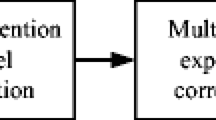Abstract
For the purpose of extracting attention regions from distorted videos, a distortion-weighing spatiotemporal visual attention model is proposed. On the impact of spatial and temporal saliency maps, visual attention regions are acquired directed in a bottom-up manner. Meanwhile, the blocking artifact saliency map is detected according to intensity gradient features. An attention selection is applied to identify one of visual attention regions with more relatively serious blocking artifact as the Focus of Attention (FOA) directed in a top-down manner. Experimental results show that the proposed model can not only accurately analyze the spatiotemporal saliency based on the intensity, the texture, and the motion features, but also able to estimate the blocking artifact of distortions in comparing with Walther’s and You’s models.







Similar content being viewed by others
Abbreviations
- HVS:
-
Human Visual System
- FOA:
-
Focus of Attention
- LGN:
-
Lateral Geniculate Nucleus
- hMT+:
-
human Middle Temporal+
- IPS:
-
Intra Parietal Sulcus
- FEF:
-
Frontal Eye Field
- VQEG:
-
Video Quality Experts Group
- HRC:
-
Hypothetical Reference Circuits
References
Aziz MZ, Mertsching B (2008) Fast and robust generation of feature maps for region-based visual attention. IEEE Trans Image Process 17(5):633–644
Chen WH, Wang CW, Wu JL (2007) Video adaptation for small display based on content recomposition. IEEE Trans Circuits Syst Video Technol 17(1):43–58
Kalanit GS, Rafael M (2004) The human visual cortex. Annu Rev Neurosci 27:649–677
Koch C, Ullman S (1985) Shifts in selection in visual attention: toward the underlying neural circuitry. Hum Neurobiol 4(4):219–227
Ma YF, Zhang HJ (2002) A model of motion attention for video skimming. Proc Int Conf Image Processing 1:22–25
Niebur E, Koch C (1998) Computational architectures for attention. In: Parasuraman R (ed) The attentive brain. MIT, Cambridge, pp 163–186
Rapantzikos K, Tsapatsoulis N, Avrithis Y, Kollias S (2007) Bottom-up spatiotemporal visual attention model for video analysis. IET Image Processing 1(2):237–248
Serences JT, Yantis S (2006) Selective visual attention and perceptual coherence. TRENDS Cognit Sci 10(1):38–45
Shih HC, Hwang JN, Huang CL (2009) Content-based attention ranking using visual and contextual attention model for baseball videos. IEEE Trans Multimedia 11(2):244–255
Stefan W, Praveen M (2008) The evolution of video quality measurement: from PSNR to hybrid metrics. IEEE Trans Broadcast 54(3):660–668
Tang CW (2007) Spatiotemporal visual considerations for video coding. IEEE Trans Multimedia 9(2):231–238
Tang CW, Chen CH, Yu YH, Tsai CJ (2006) Visual sensitivity guided bit allocation for video coding. IEEE Trans Multimedia 8(1):11–18
Treisman AM, Gelade G (1980) A feature-integration theory of attention. Cogn Psychol 12(1):97–136
VQEG (2000) Final Report from the Video Quality Expert Group on the Validation of Objective Models of Video Quality assessment. VQEG. http://www.vqeg.org
Walther D, Koch C (2006) Modeling attention to salient proto-objects. Neural Netw 19:1395–1407
You JY, Liu GZ, Li HL (2007) A novel attention model and its application in video analysis. Appl Math Comput 185:963–975
Yuen M, Wu HR (1998) A survey of hybrid MC/DPCM/DCT video coding distortions. Signal Processing 70:247–278
Zheng YY (2008) Research on H.264 Region-of-Interest Coding Based on Visual Perception. PhD Thesis, Zhejiang University. China (in Chinese)
Acknowledgements
The authors would like to thank the editor and anonymous reviewers for their careful reviews and valuable comments.
Author information
Authors and Affiliations
Corresponding author
Rights and permissions
About this article
Cite this article
Zhang, H., Tian, X. & Chen, Y. Video image assessment with a distortion-weighing spatiotemporal visual attention model. Multimed Tools Appl 52, 221–233 (2011). https://doi.org/10.1007/s11042-010-0470-x
Published:
Issue Date:
DOI: https://doi.org/10.1007/s11042-010-0470-x




